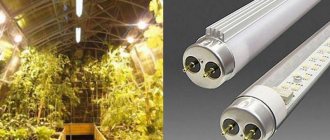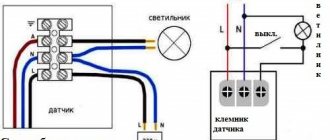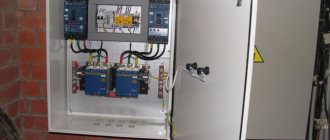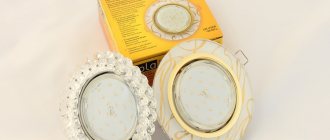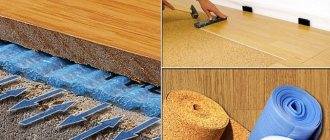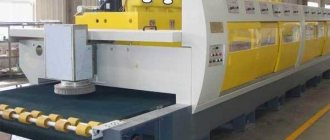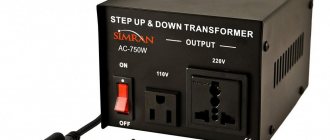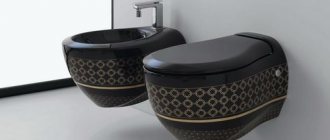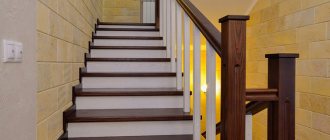It is difficult to overestimate the importance of lighting devices in modern society. They are used wherever “a person’s foot steps.” This led to a wide variety of lamps of different categories.
An LED spotlight is no exception: in electrical stores and on the pages of numerous online stores you can find many varieties of these products, differing in features and technical and operational characteristics that affect the operating conditions and the final cost of the device. To choose the right spotlight, it is important to understand all the varieties, study the differences, advantages and disadvantages.
Types of spotlights by light source
Depending on the light source used, floodlights are divided into four main types. They come in halogen, sodium, LED and metal halide. More details about each type:
- In the first, a halogen lamp is used as a light source. In essence, we are talking about an improved incandescent lamp. The differences are associated with the internal cavity of the flask, which is filled with an inert gas, which increases the glow and service life.
- Sodium floodlights are powered by a gas-discharge lamp. Unlike the first type, the flask does not contain inert gases, but sodium vapor that emits light.
- Metal halide lamps differ from halogen lamps in the use of a gas-discharge lamp, higher brightness and more complex design, supplemented by an ignition unit. Special operating rules must be observed.
- LED spotlights operate on a matrix with LED diodes. Unlike others, they are more compact and durable.
LED spotlight device
This device consists of three main elements - a housing, a matrix with LEDs and a driver for current stabilization. In terms of the set of components, the device is no different from a conventional street-type LED lamp.
The LED matrix is hidden under a transparent protective cover with installed glass and reflectors. By unscrewing the fasteners, you can remove the cover and gain access to the LEDs.
Typically, the housing of the lighting fixture is made from cast aluminum and other corrosion-resistant metals. The choice in favor of aluminum is due to its excellent heat dissipation properties. The matrix inside the case is secured with additional screws, of which there can be from two to four pieces. For more reliable operation of the product, manufacturers of high-quality products eliminate the gap between the body and the matrix and add heat-conducting paste.
On the back of the spotlight there is a cable for connecting to the power supply. The presence of a rubber washer installed in the hole protects the device from moisture. Some products are available with rotating brackets that provide good attachment to towers and poles. The option with ribbed casing walls is even better, as it provides maximum heat dissipation.
Below the back cover of the LED spotlight, a power supply is installed, which is used to transform the industrial network current with a voltage of 220 volts into direct current suitable for operation of the device.
Electrical circuit of LED floodlight
The photo shows a typical electrical circuit of an LED spotlight driver. The operating principle of any spotlight driver circuit is the same.
Voltage from the household network is supplied to the driver input through fuse F1, filtered using LC elements and rectified by a diode bridge. Next it is smoothed out by electrolytic capacitor C13. A DC voltage of about 280 V is created at the capacitor terminals.
From capacitor C13, voltage is supplied through current-limiting resistors to zener diode D12 and pin 6 of the microcircuit. The zener diode provides power to the microcircuit with a voltage of 9 V, which is the reference for the operation of the driver as a whole. From capacitor C13, voltage is also supplied through the winding of transformer T1.1 to the output of field-effect transistor Q1 operating in switch mode.
The driver works as follows. From pin 5 of the microcircuit, high-frequency pulses are sent to the gate of transistor Q1, due to which the resistance between its drain and source becomes close to zero. At this moment, a current passes through the primary winding of the transformer, due to which voltage appears on the secondary winding. It is rectified by the high-speed diode SF28 and smoothed by the electrolytic capacitor SC1. The amount of current flowing through the LED matrix is determined by the resistance value of the resistors installed from pin 3 of the microcircuit to the common wire.
The most common ones that fail are electrolytic capacitors (they are easy to identify by their appearance - they are swollen), bridge rectifier diodes, a field-effect transistor, a high-frequency diode and a zener diode (if it breaks, the microcircuit fails).
The reason for the burnout of the LED matrix in the spotlight
Typically, LED matrices fail due to overheating. I decided to figure out why the LED matrix in this spotlight, despite the thick-walled duralumin body, which is also a radiator, burned out.
The first thing that caught my eye was that the matrix was secured with two screws, and not four, which is provided for by its design. The screw heads were conical, which could lead to deformation of the matrix substrate if the screws were tightened too tightly.
After unsoldering the current-carrying conductors and unscrewing the screws, the matrix was easily separated from the spotlight body. The photo shows the appearance. Recesses in the corners of the substrate instead of holes reduce the likelihood of it being evenly pressed against the radiator.
The reason for the burnout of the LED matrix became obvious after examining its reverse side. The area of the substrate opposite the burned-out area with LEDs was not covered with heat-conducting paste, although the paste on the body of the spotlight was applied evenly.
Typically, the section of the radiator to which the fuel element is pressed is ground. In the spotlight, this rule is doubly violated, since the area of the body to which the LED matrix is pressed is not polished, and is also painted with shagreen paint, which significantly reduces heat removal from the matrix.
Based on the above, we can conclude that the LED matrix failed due to overheating due to its poor pressing to the spotlight body during assembly.
Before installing the matrix into the spotlight body, the contact area was sanded with sandpaper until the aluminum shined and fresh thermal paste was applied.
Advantages and disadvantages
Both positive and negative aspects are highlighted when using these devices. First, let's list the advantages of LED spotlights:
- minimum energy consumption - 8-10 times lower than when using conventional incandescent lamps, and 3-4 times less compared to energy-saving products;
- long service life - at least 10 years;
- In production, environmentally friendly materials are used that do not pose a threat to humans and the environment.
As for the disadvantages, the following can be noted:
- high cost - and in the case of floodlights with LED diodes, the declared service life does not always correspond to reality, so the devices for the most part do not pay for themselves (however, if technical standards are observed and additional reinsurance is available, the product will work for at least 7-8 years);
- continuous operation leads to failure of LEDs - the brightness gradually decreases, subsequently the components completely burn out;
- To increase durability, it is advisable to use additional cooling sources and a power supply, which again leads to financial expenses.
Classification of LED spotlights
When choosing a device, they are guided by various parameters that allow them to be classified. Spotlights vary in power, and this parameter can vary between 10-1000 W. The situation is similar with brightness, which can be 700 or over 30,000 lm.
IP protection class
Things are much more interesting with the degree of protection (Internal Protection). The IP XY marking indicates how well a device resists dust and moisture, where X and Y are expressed in numerical values. The higher they are, the better the protection.
Here are examples:
- IP20 - such lighting devices can be used for indoor lighting systems, since they are not protected from dust and moisture.
- IP21-22 are more advanced products that are used in unheated rooms (protected from condensation).
- IP23 - these devices are practically no different from the previous ones, except that outdoor installation is acceptable.
- IP50 – the body of the floodlights is protected from dust, which allows them to be used in industrial facilities. At the same time, there is no protection against moisture.
- IP54 is an improved version of previous devices with additional moisture protection. Suitable for use in rooms with high humidity levels.
- IP67-68 – high level of insulation, which allows the devices to be used underwater.
Range
The spectrum of devices is expressed in color temperature and can range from 3500 to 6500 K. With increasing color temperature, luminous efficiency increases, but the shade becomes paler and colder. As for the dependence of the luminous flux on power and temperature, the following can be cited as an example:
- 40 W spotlights with a color temperature of 6500 K are characterized by a flux of 4000 lm;
- when the temperature drops to 5000 K, this parameter will be equal to 3600 lm;
- 3500 K – 3000 lm, etc.
Spotlights with a temperature of 3700-4300 K emit warm rays, 4500-5500 K – neutral, 6000 K and above – cold white rays.
Cool colors are considered more effective when illuminating large areas and have a blue tint. If you are going to illuminate the reading area or work area, then the color temperature should not exceed 5000 K.
Note. You can often find multi-colored LED spotlights using RGB technology.
Matrix
The matrix for LED spotlights can consist of two types of diodes - cluster and SOD. Matrices with numerous SOD diodes are cheaper than products with cluster components. On the other hand, the presence of a large number of light-emitting elements leads to a scatter of parameters. When one or two fail, the load on all the others increases. The service life of cluster devices is 3-4 times longer (but the cost is 30-40% higher).
Cluster spotlights contain a matrix with ultra-bright LEDs of the 5050, 5630 series and identical parameters. The small surface area emitting light results in a uniform flow, and the service life reaches 30,000 hours without loss of efficiency.
What is an LED spotlight made of?
This is a very simple device for the end user. Simplicity is achieved due to the fact that high technologies were used in the production of the projector’s components, which were only written about in scientific journals ten years ago.
Once, in my distant childhood, I bought a red LED at Cultural Sports Goods for 40 kopecks. The entire radio circle was jealous of me...
The spotlight has two components: LED and Driver. The 220V voltage is supplied to the Driver input, and from it to the LED power supply. This is very short and simplified.
Spotlight 20 W photo. Installed under the canopy of the entrance, which faces Udelny Park, St. Petersburg.
So, how does an LED floodlight work? Let's take a closer look at each part, and I'll provide photos and links along the way.
The main parameter of the spotlight is power, which is usually 10, 20, 30, 50, 100 W. Another parameter is the color of the glow. There are basically two colors on sale – cool white (it’s brighter) and warm white (it’s easier on the eyes). In terms of moisture resistance, there is only one type - street.
Floodlight LED (LED Matrix)
Other options for the name are LED matrix (they are often confused with the matrices on which the “running lines” are made), LED chip, LED assembly or module. In English – LED Chip.
The terminology here is not completely settled, but I can say that the words “LED module”, as a rule, mean a light-emitting device using discrete LEDs, which are soldered onto one heat-conducting substrate. There will be a photo at the end of the article.
Such a matrix, as a rule, consists of several LEDs (up to 100 pieces) connected in series-parallel. The LEDs in the matrix are made using a special technology, which makes it possible to obtain crystals with identical characteristics.
LED module (assembly). Do you see two horizontal rows of 10 dots in the yellow square? These are LEDs.
It is worth saying that ordinary LEDs cannot be connected in parallel due to the fact that they always have a variation in parameters. As a result, some will overheat, others will burn at full heat, and the entire structure will quickly burn out.
The matrix has two pins for power supply, plus and minus. They cannot be confused. However, if you mix it up, nothing bad will happen - there will simply be no light.
It is very important to ensure good heat dissipation from the LED matrix; I have written about this in my articles more than once. Overheating of LEDs above 50 degrees reduces their service life - the brightness drops over time. We can absolutely say that the service life of an LED chip definitely depends on the operating temperature.
For example, all other things being equal, the operation of two matrices at temperatures of +10 and +50 will lead to the fact that in a year the second matrix will shine 2 times dimmer than the first.
The temperature of the matrix depends on several factors, here they are:
- the presence of a radiator (a heat sink that removes heat from the spotlight into the environment)
- heat removal from the assembly (correct installation through thermal paste, ensuring minimal thermal resistance)
- operating current, which must correspond to the nominal value (the current can be reduced, as a result the service life will increase, but the brightness will decrease)
We can say that the current value of the LED chip selects a compromise between service life and brightness.
Selection options
When choosing LED floodlights, there are many factors and parameters to consider, as listed below. It is also worth paying attention to the material from which the case is made, the thickness of the radiator and the degree of protection.
Housing material
Some devices are made of stainless steel with an aluminum alloy reflector. This is a good option if the LED spotlight is used inside living rooms, but if it is necessary to use it outdoors, then it is better to avoid such a design (corrosive processes will begin at the junction of two metals).
Radiator thickness
Never skimp on the heatsink - along with the driver, it is the most important component that extends the longevity of the device. The fact is that a bad radiator is not able to ensure normal heat removal from the matrix. When choosing between two identical LED spotlights, choose the one with the largest radiator.
Protection class
We also do not recommend saving money by buying floodlights without protection from dust and moisture. This is especially true for cases where the device will be used outside the building. Ideally, you should look for a housing with at least IP54 protection.
Driver
The power supply that converts alternating current into direct current has its own service life. Such an electrical element consists of electrolytic capacitors, which dry out over time and lose their capacity. An ordinary capacitor is designed for uninterrupted operation for 10,000 hours; for a good device, the parameter can increase to 30,000, for an expensive Japanese one – up to 50,000.
Pay attention to the tightness of the driver. If there is no sealant or compound on the board, it will soon fail if exposed to the slightest moisture.
About CoB technology
Typically, LEDs with primary optics have an emission angle of about 120 degrees. When creating other angles, secondary optics elements are used. Basically these are different collimator, focusing lenses, parabolic, elliptical reflections.
Thanks to Chip on Board technology, it is possible to create powerful point light sources in the form of an array of LED crystals, which are installed in one board that can provide heat removal from phosphor-coated crystals.
In the form of a board when mounting crystals, a copper alloy is used, as well as a material with high thermal conductivity, which makes it possible to obtain very low thermal resistance and ensure effective heat dissipation.
Recommendations for selection
As always, you can’t get hung up on a specific manufacturer, since different companies produce devices that have different operating conditions. Every place has its advantages and disadvantages, so the final choice will depend on your own preferences and planned financial expenses.
However, there are nuances that are worth paying attention to:
- According to statistical data, devices from branded manufacturers are much more efficient and durable than cheap Chinese ones made from low-grade materials.
- Even trusted manufacturers have a certain percentage of defects or defects. Somewhere the technical control service was gaping or they were advised to “close their eyes.” Due to such reasons, a store may end up with a low-quality branded product. That is why you cannot focus only on a specific manufacturer.
- The higher the cost of the device, the longer the service life and warranty service, which allows for free repairs or replacement of the product in the event of an unexpected failure, if operating conditions have not been violated. Chinese diode spotlights usually do not have this option.
- Pay attention to the numerous additional functions that will come in handy during operation. For example, lamps can be supplemented with motion sensors and photographic relays, which will simplify operation and save on electricity. You independently set the period of time during which the spotlight will glow.
- Spotlights are divided into stationary or mobile. In the first case, for reliable operation, the devices must be fixed to the wall, ceiling, pole, etc. Moreover, to move the equipment from place to place, you will have to dismantle it. The second option provides the ability to conveniently move the spotlight and is the best when the lighting device needs to be installed on construction sites, vegetable gardens, etc.
- For street floodlights, the degree of protection of the housing must be at least IP65. It would be ideal to purchase a device with IP68, but the cost of such products is much higher. Despite this, when lighting a yard or summer cottage, try to hide the spotlights under canopies and other protective elements.
- At home, LED spotlights with a matrix or one powerful diode can be used.
- Give preference to a device with an aluminum body.
- The functionality of the device depends on its shape. Square products can be used for uniform illumination of large areas, while round ones provide a directed flow to certain objects. Oblong ones are used to illuminate pools, ponds, building facades or in landscape design.
Spotlight repair
The repair consisted of dismantling the burnt-out matrix and faulty driver and installing a modern LED matrix with a built-in driver, and an additional rectifier bridge circuit with an electrolytic capacitor into the spotlight housing.
LED matrix installation
In order to get to the matrix, you need to remove the protective glass and the reflector, which requires unscrewing four screws.
To remove the matrix, you need to unsolder or bite off the wires with side cutters and unscrew four more screws. When the matrix was removed, it became clear why it burned out. The heat-conducting paste did not cover its entire surface.
In addition, the installation site was painted, and there were raised areas around the mounting threaded holes, as well as around the strange rectangular recesses. There is a design flaw and careless assembly by the manufacturer of the spotlight.
The burnt matrix had dimensions of 20x20 mm, and the one being installed was 40x60 mm, so new mounting holes had to be made. When marking, we also had to move the matrix relative to the central axis so that the mounting holes would not fall into the heat-dissipating fins of the case. In addition, it was also necessary to leave one of the two holes for routing wires. I didn’t want to drill a new hole for the wires, since the standard one was hermetically connected to the back of the spotlight.
After marking, four holes with a diameter of 2 mm were drilled and then threaded with an M2.5 tap.
The fitting showed that all the holes made coincided exactly with the mounting holes of the matrix. If I missed a little, the holes in the matrix can be sawed using a needle file. There are no current-carrying paths or elements near them.
The next step is to use medium-grit sandpaper to prepare the heat-dissipating surface by stripping off the paint and removing any raised bumps.
After ten minutes of work, the surface became perfectly flat and ready for attaching the matrix. The remaining mounting holes have a small area and will have virtually no effect on heat dissipation.
For good thermal contact of the matrix substrate with the aluminum body of the spotlight, which is also a radiator, the place where they are connected must be coated with a thin layer of a special heat-conducting paste. It is convenient to spread the paste using a bank card or business card. The paste is sold in computer stores, and can be ordered on Aliexpress when purchasing a matrix.
The matrix is fixed in the housing using M2.5 screws with flat washers to increase the pressing area. It is better to tin the contact pads of the matrix and solder the wires before installation. I used double-insulated wires, but for reliability it is advisable to use a special heat-resistant wire. I didn’t have one of sufficient length on hand.
The reflector of the spotlight had an opening for the luminous flux of the matrix of insufficient size; it had to be modified after marking.
To do this, using a mini drill and an emery disc, the reflector was sawed along the edges. The edges are folded over with pliers and the excess metal is cut off with scissors.
The photo shows the result of installing an LED matrix with a driver on the substrate. Its entire light-emitting surface is open to light flux.
Installing a diode bridge and capacitor in the spotlight
I did not make a printed circuit board for mounting six radio elements, especially since there was a suitable board from the LED lamp driver available. I removed the excess elements from it, soldered in a fuse and a current-limiting resistor.
The wires coming from the LED matrix were soldered directly to the terminals of the capacitor, and its terminals were already soldered to the board. One of the wires of the power cord was soldered to the board, and the second to the output of the switch, and from there to the board.
To insulate the printed circuit board, a shortened package from Tic-Tac dragees was used. Fits perfectly. A slot was made in the package for the power cord.
The LED spotlight has been repaired without using a driver, and you can start testing it. When I first turned it on, it didn't light up. It turned out that the installed fuse for a protection current of 1 A could not withstand the starting current of charging the capacitor and burned out.
I didn’t want to increase the value of the current-limiting resistance, so I had to install a 2 A fuse. When turned on and off repeatedly and for long periods of time, the spotlight shone without fail. The case heated up slightly.
A budget option
Today on the market you can find products from several branded manufacturers. The companies Philips, Osram, and Hyundai have long established themselves, but the products of Feron, Luna, and Jazzway are practically not inferior to them.
There are also domestic options, which are much better than cheap Chinese products with inflated parameters according to the passport. We bring to your attention a review of inexpensive 50 W floodlights from three different manufacturers:
| Name | Foton FL-LED MATRIX | FERON LL-133 1LED | IEK |
| Luminous flux, lm | 4000 | 4700 | 4000 |
| Color temperature, K | 4200 | 4000 | 4200 |
| Degree of protection (IP) | IP65 | IP65 | IP65 |
The degree of protection indicates that such options can be used outdoors. The cost of each of the listed spotlights does not exceed 2,500 rubles. The actual value of the luminous flux is lower, but not more than 5-10%. The operating temperature range everywhere is from -40 to +60 degrees. Celsius. Still, it is worth paying attention to the radiator - if it is small, then it is not recommended to turn on the device on a hot summer day.
An LED spotlight is a universal lighting device used in many areas of life. More expensive models can be used in almost any conditions. They are characterized by high-quality luminous flux, minimal energy consumption and no need for constant maintenance during the entire service life. If possible, you should buy devices from branded manufacturers. But there are also decent options among lesser-known companies!
